Proven Truths of Effective SEO Copywriting (Told by an SEO Expert)
Can we all agree on one thing?
Copywriting sucks.
Well, it does. Especially if you’re throwing darts in the dark and hoping something sticks.
There has got to be a better way.
We want to first commend you for diving into research to up your game.
That’s the first step.
The second step is to digest what we are about to say in this blog.
We promise, it won’t be a waste of your time.
You can trust Overlap for the following reasons...
We have been in the SEO game for a combined 23 years.
We service high-profile clients who require us to be on top of the ever-evolving industry.
And (self gloating alert) - we won the award for "Excellent In SEO" at the 2021 AZIMA awards. For those of you who don't know what these are (yes, that should be all of you), it's like the equivalent of the Super Bowl for SEO nerds like us.
With all of that being said, we’ve established one hard truth: SEO copywriting is hard.
In this piece, you will develop a better understanding of what SEO copywriting is. You will learn practical tips that are easy to implement. You will also learn how to satisfy the requirements of good SEO practices while maintaining a good writing style aimed at converting a user.
Ready?
Let’s dive into it!
What is SEO Copywriting?
The reality of the situation is that there is no one ‘official’ definition of the concept.
But generally speaking, SEO copywriting is referring to the art of creating copy for a webpage aimed at doing two things: rank well and convert a user.
This is no easy feat.
In fact, it is one of the hardest things to do in digital marketing.
The reason is simple.
Some on-page ranking signals are in direct opposition to good copywriting.
In other words, optimizing your page to garner higher rankings for target keywords doesn’t help with getting your reader to convert.
For example, the Htag structure of a page is one of the most powerful on-page ranking signals.
Therefore, including your target keyword(s) and LSI (latent semantic indexing) versions of such will give you some SEO juice. Search engines eat this up when spiders come to crawl your page.
They love it for this simple reason.
It becomes easy for them to understand what the page is about. Therefore it makes it super easy for them to index your page in the right spot in the labyrinth of Google.
Here’s the issue.
These kinds of expectations breed boring writing.
There we said it.
Most SEO content out there sucks, it’s yawn material.
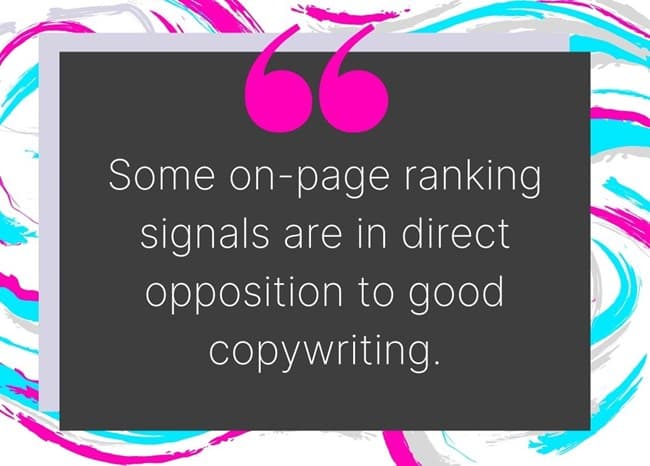
The majority of the content published on the cosmos of the internet speaks to robots, not humans.
Fortunately, some content out there doesn’t suck.
There is a way to speak to the writer while maintaining good SEO practices.
In the following sections, we will dig into this where you will come out with actionable and practical ways to execute on this.
Choose Your Words Wisely
There are some words in the English dictionary that are known to be ultra-effective in the copy world.
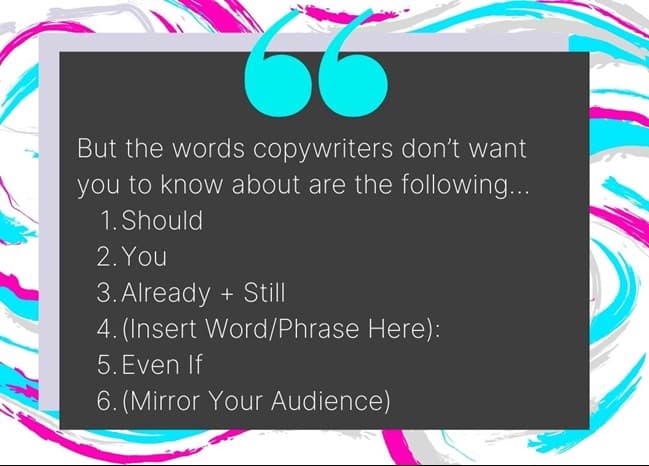
Pay attention to this part.
Why? Because it’s the easiest change you can make that can result in the biggest difference.
First and foremost, let’s get the obvious ones out of the way.
The words ‘because, ‘free’, and “new” should be implemented where you can. These are the more known words that are effective at converting users.
But the words copywriters don’t want you to know about are the following…
Should
The word ‘should’ taps into the unrealized destiny of the reader. A copywriter might use the word “could” in their copy, but this doesn’t invoke a sense of destiny.
One way of putting it is by relating this back to the movie Shawshank Redemption. [SPOILER ALTER] The main character Andy Dufresne is falsely accused of a serious crime that lands him behind bars. It isn’t that Andy ‘could’ be on the other side of those walls, it’s that he ‘should’ be.
Using this kind of wording could result in big changes to your conversion rate.
You
This one is simple, the use of ‘you’ allows your reader to feel like they are personally being spoken to.
It is all too often that copywriters try writing for far too many personas. As a result, they sound impersonal and bland.
A simple shift in using the word ‘you’ can change the tone from general to personal, which is what you are shooting for every time in copywriting.
Already + Still
Let’s break these two words down.
The use of the word ‘already’ is intended to speak to the reader’s sense of empowerment.
And the word ‘still’ invokes a sense of motivation to act on our feelings due to unfinished business.
To be told that we are at the beginning of our journey is deflating.
On the other hand, to be told that you’re almost there motivates us to push through the hard parts.
Imagine doing a 2-minute plank. Would you rather have the feeling of dread before starting or the feeling when you’re 10 seconds away from accomplishing your goal?
You’ve already taken the first steps in improving your SEO copywriting skills, but you still feel like there’s a missing piece.
We’ve got you covered. Read on to find out what that is.
(insert word/phrase here):
Just to clarify, “insert word or phrase here” literally means you can insert any phrase there.
These are meant to break the text up, make it more readable, and retain your reader’s attention.
Even in this piece, this tactic has been implemented. It is all aimed at taking a dry block of content and previewing the reader where they will find value.
This means using line breaks, with one word or a phrase. For example, the way we use “pay attention to this part” above.
Using a colon after your bucket brigade is totally up to your discretion. Most SEO copywriters do, but this piece doesn’t. People don’t read good content for a grammar lesson.
The point is to keep your content short and sweet, and to draw your readers in when it might be getting dry.
Even if
‘Even if’ is a long-used and totally undervalued phrase. It is essentially a form of objection handling.
If your audience is well known, then you, as the writer, should know what kind of objections your reader may have. Speaking to those on the spot helps alleviate any anxiety or doubt the reader may have.
This also cultivates a sense of trust, as if you are speaking directly to the reader in a way that you truly understand them.
The truth is this.
The further away you can distance yourself from coming off as cookie-cutter, the more personable and successful you will be with your SEO copywriting.
(Whatever Your Audience is Saying)
The last one is simple, mirror your readers. On the same point as above, if you know the audience you are speaking to well, then you should know the phrases they use most often.
Mirror them!
Again, this cultivates a sense of trust & understanding.
Humans have done this since the dawn of man & woman. It’s a form of flattery and social engagement that conveys connection and understanding.
Hook Your Reader in the Intro
“Look
If you had
One-shot
Or one opportunity
To seize everything you ever wanted
In one moment
Would you capture it
Or just let it slip?”
Eminem had it right because we’re prettyyy sure he was talking about writing intros for SEO copywriting.
No? Okay maybe not… but the point still stands.
You have one shot to make a good impression when meeting someone in person, and the same goes for writing content.
In order to do this, it’s as easy as following this 3 step process.
Structure your into with:
1. Agree
2. Promise & Preview
3. Trust
Now let’s dive into what each of these sections mean.
Agree
Hooking your reader in starts with empathizing with them.
This means putting yourself in the reader’s shoes and understanding the problem they are trying to solve. By overtly agreeing with your reader, you lay the foundation of understanding and trust down.
When you feel like someone understands you, you listen.
Promise & Preview
Next up… preview your reader with the content to follow.
Take this a step further and promise what you think the reader will take away from reading your content.
In this way, you offer what value your content has upfront. This allows your reader to make the decision as to whether or not they want to invest their time reading it. People appreciate options.
Trust
The last section of your intro should be dedicated to displaying your trust value.
Answer questions like, what qualifies you to be talking about this subject? What kind of credentials do you have? What is the success you’ve achieved with the knowledge you are about to reveal?
If done right, this last section solidifies your reader’s attention.
Even if they do not end up agreeing with your content, they can still appreciate it.
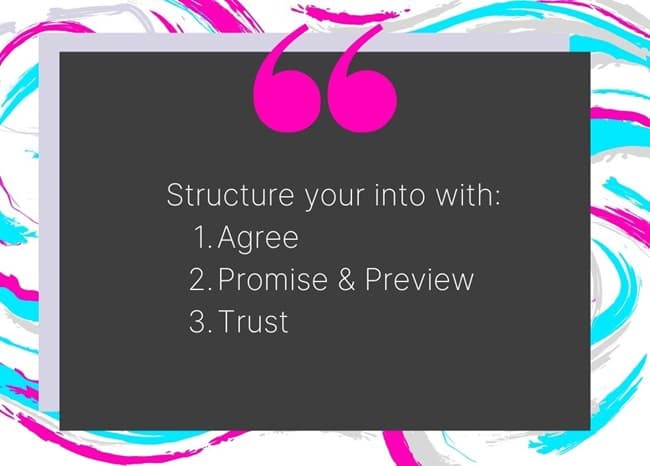
Structure the Meat of Your Content With Purpose
If you’re going to hook your reader in with a phenomenal intro, don’t catfish them with subsequent content that dulls the brain.
Set expectations with your reader and deliver on all the goodness.
The body of the content is the easiest part to ramble on. It’s the section where you might lose the interest of your reader.
It is your duty to keep them engaged.
If a reader has been gracious enough to view your work, titillate the senses by entertaining the sh*t out of them. Otherwise, what’s the benefit the reader gets?
Not sure how to do that?
We have some pointers:
1. Use Bucket Brigades
A block of text can easily trigger unwanted flashbacks of high school English where drooling of boredom was a common occurrence.
Don’t remind your reader of those boring days.
Break content up and excite them for what’s to follow.
This is the exact concept mentioned in the ‘Choose Your Word Wisely’ section.
For some weird reason, the concept is called a bucket brigade, couldn’t tell you why.
Now here’s the thing you won’t believe.
Actually, the statement above was just a way to demonstrate the use of a bucket brigade. Sorry to leave you hanging there, just trying to illustrate a point.
Bottom line, eliminate the use of blocks of content by breaking it up with bucket brigades. This will make the body of your content much more enthralling.
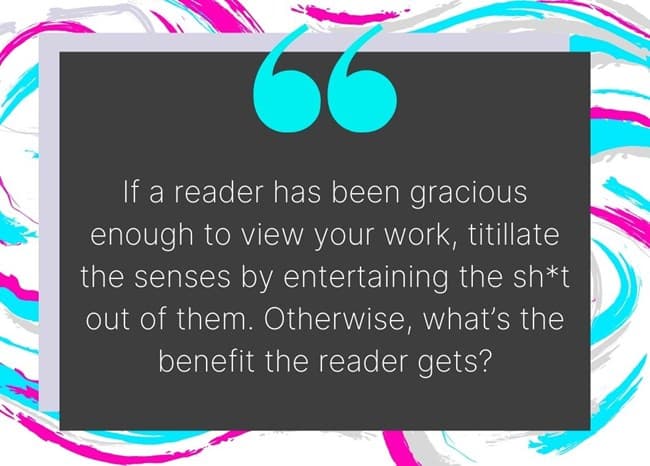
2. Implement Good On-Page SEO Practices
Most of the time, mixing SEO and good content is like trying to mix oil & water.
It’s either recycled content aimed at pleasing the algorithm gods or just good content with a writer who doesn’t choose to implement good SEO practices.
We’re here to tell you this doesn’t have to be the case.
The conception of SEO was initially formalized to serve the reader and not the bots, but the practices evolved beyond that.
Think of the incentives.
Why write good content if the search engines aren’t going to crawl and index it favorably?
Give the bots what they want and you will be rewarded with page 1 rankings.
Writing for bots does not benefit human readers.
We’ve become so conditioned as a reader, that when we read resources on page 1 of our search, most of the time, we’ve learned to skip past all the nonsense by skim-reading until we get what we need.
There’s a solution; let’s get back to the root of SEO.
That is, to serve the reader. Start doing this by building out content in what’s called a “hub and spoke” model.
When you write about a subject, write related content that refers to one another. This creates trust and authority on topics with your reader, and in turn with the ranking algorithms.
It also creates a plethora of internal links that bots love to gobble up.
Another way to understand this is by seeing content as a funnel.
You have top of funnel content that is very broad and informational. It’s the equivalent of cold calling. Get your reader to see your content, and then hook them in with the quality.
Link to a piece in the middle of the funnel.
Get more in-depth. Start to hone in on certain aspects; practices, products, whatever it is that you do.
And then link out to your bottom of funnel content where you convert your reader into a client.
Creating clusters of topics like this not only builds the quality of your content but delights the bots that crawl your site.
3. Don’t Regurgitate Content
If there was a way to write the feeling we get after seeing a barefoot person on a plane, that’s how we’d describe 90% of the content on the web.
This collection of content is just recycled and regurgitated information.
Might as well call it “My Sister’s Blog”, because content nowadays is just hand-me-downs passed from one blog to another.
We know, many of the writers out there aren’t journalists, and creating unique content just doesn't exist nowadays, but please, oh please, don’t just rewrite another blog you read.
We can guarantee your reader will lose interest 90% of the time.
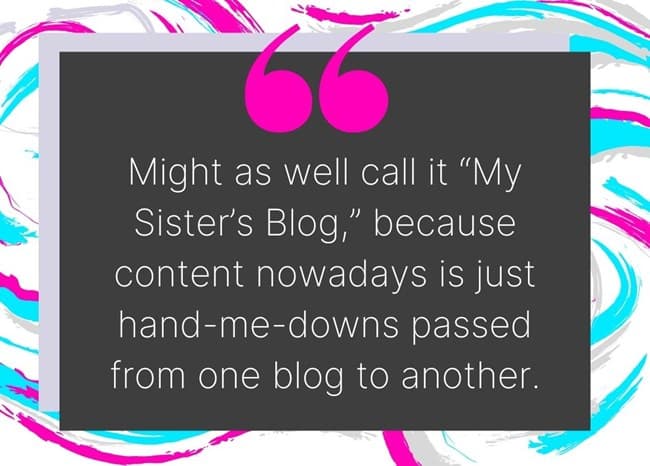
So what do you do instead?
Do your research. Include solid resources. Try to find the source of truth by reverse-engineering citations.
Dare I say it, provide real, genuine value to your reader.
Add Some Flair on Your Page
Have you ever landed on a page to be met with a stock imagery and immediately lost all interest in reading it?

Ouf, see what we mean?
For as accurate as the statement above is, the opposite is equally as true.
Custom imagery calls to your reader. It captures their attention and communicates to them, ‘hey, we’ve spent a lot of time on this, so your time and energy are well spent here.’
You're going to sense a theme here.
But it builds trust with your reader.
That is what it is all about, trust.
It also provides skim readers with an understanding of what your content is all about.
For those who like to dive into the meat of the content, the opposite exists where they skim and look at the imagery to understand what the content is all about.
Don’t lose out on a big opportunity to capture the attention of these readers.
Custom illustrations, even block quotes of pertinent parts are what will make your content stand out.
Not to mention all the more entertaining.
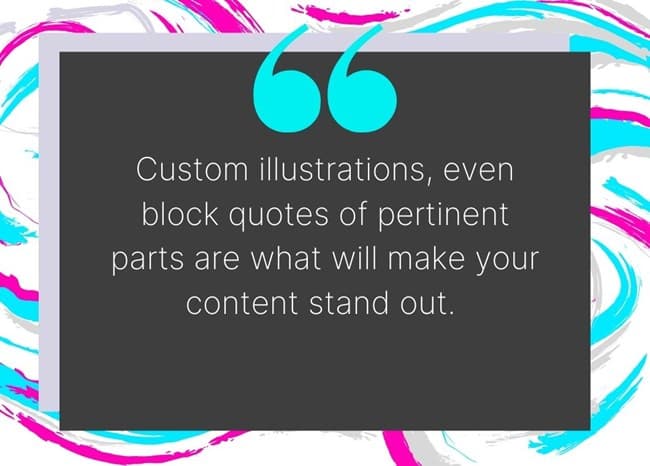
Gain Your Readers Trust
You’ve made it, bravo. The last truth of effective SEO copywriting; gaining your readers trust.
Source your info with reputable resources.
This speaks to the point about reverse-engineering your sources when researching a topic to write. *Refer to the Don’t Regurgitate Content section above.
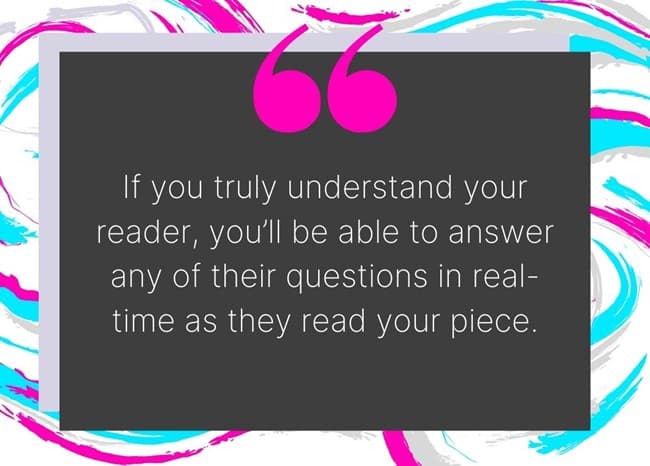
Your goal is to find the original source of truth and cite that source for your reader to see.
Maybe you’re already citing great resources, but your readers still aren’t spending a lot of time on the page?
Gain more of your reader's trust by speaking to their emotions.
If you truly understand your reader, you’ll be able to answer any of their questions in real-time as they read your piece.
If you’re able to do this, you’ve officially unlocked the holy grail to content marketing.
Speaking to a reader directly is the ultimate way to gain trust.
Envision any objections a reader may have, and speak to them right there in the body of the content. *Refer to the section ‘Even If’ above.
When done right, objection handling is level 99 of copywriting. Master that, and you’ve mastered copywriting.
Final Words
We know, we know, you’re thinking that this all sounds a bit overwhelming.
But let’s bring it back to where we started.
SEO copywriting doesn’t suck, it’s hard.
And it doesn’t have to be when you have the right tools and skills in place.
If we’ve done our job right, this piece should leave you in a better position, with a sense of delivering on our initial promise to not waste your time.
In the name of ridding page 1 rankings of dry SEO content, we hope this has inspired you to replace it with mind-blowing reading material.
Again, we’ve been in the SEO game for a combined 23 years. And if this is just feeling like it isn’t your cup of tea, hit us up. We can help.
Happy writing!
